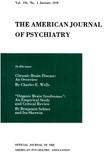WHAT HAPPENS TO PATIENTS WHO ARE HOSPITALIZED FOR THE FIRST TIME WHEN OVER SIXTY-FIVE YEARS OF AGE
Abstract
Studying all first admissions of patients over 65 years old to the state mental hospitals in Maryland, during 1938, 1939 and 1940, we found:
(A) The group 65-69 years old was larger than the other groups; 65-69, 30%; 70-74, 26%, 75-79, 21%; 8o up, 23%.
(B) There were 12% more males than females. No significant difference was noted in regard to race. The percentage of negroes (18% for negro against 82% for white) corresponds to the proportion of negro population in the state. There is some difference regarding sex among the colored patients [See Table 6 in Source PDF] (65% colored male against 33% colored female).
(C) Regarding marital status, there were many more married (34%) and widowed (46%) than single (16%) and divorced (4%). Among the married, there were more male (73%) than female (27%); the same was observed among divorced (male 80% and female 20%). More than one-half of the patients over 75 years of age were widowed.
(D) Eighty-five percent of our patients over 65 years of age were diagnosed either as psychotics with cerebral arteriosclerosis (37%) or senile psychotics (48%).
Following up all patients for three years after admission, we found:
(1) In the first year 47% died and 8% were discharged as improved or unimproved. During the second year, 11% more died and 1% were discharged. In the third year, 8% died and only 0.6% were discharged. In three years there were 66% dead, 10% discharged and 24% remained under care in the hospital. Deaths occur soon after admission. Approximately 16% of all patients die during the first month, and 46% by the end of the first year. The death rate was higher for male patients (73% in three years), than for female (59% in three years).
(2) The great majority of discharges occurred in the first year following admission (82% of all discharged).
(3) In relation to diagnoses, 66% of the patients classified as psychosis with cerebral arteriosclerosis died as against 70.7% of the senile psychotics.
(4) Following up for five to six years the group of patients over 65 years of age admitted in 1938, we found that 77.8% died, 10.4% were discharged and only 11.7% remained under hospital care.
(5) The duration of life of our patients over 65 years of age was shorter than the average duration expected for the general population. For the first year after admission, the mortality rates were very high, ranging from 24 to 11½ times the mortality rates expected for the general population.
Access content
To read the fulltext, please use one of the options below to sign in or purchase access.- Personal login
- Institutional Login
- Sign in via OpenAthens
- Register for access
-
Please login/register if you wish to pair your device and check access availability.
Not a subscriber?
PsychiatryOnline subscription options offer access to the DSM-5 library, books, journals, CME, and patient resources. This all-in-one virtual library provides psychiatrists and mental health professionals with key resources for diagnosis, treatment, research, and professional development.
Need more help? PsychiatryOnline Customer Service may be reached by emailing [email protected] or by calling 800-368-5777 (in the U.S.) or 703-907-7322 (outside the U.S.).



